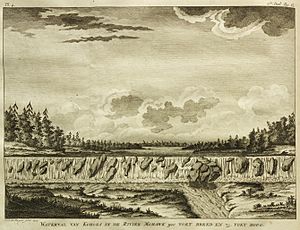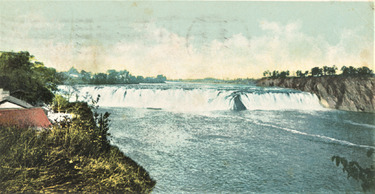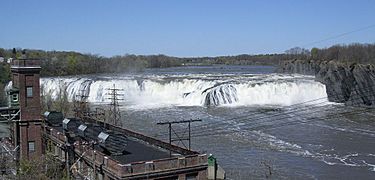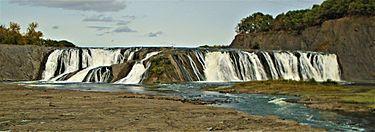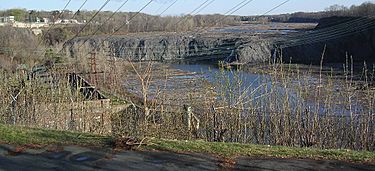Cohoes Falls facts for kids
Quick facts for kids Cohoes Falls |
|
|---|---|

from the south
|
|
| Lua error in Module:Infobox_mapframe at line 185: attempt to index field 'wikibase' (a nil value). | |
| Location | Between Cohoes and Waterford, NY, United States |
| Coordinates | 42°47′16″N 73°42′30″W / 42.78778°N 73.70833°W |
| Type | Block |
| Elevation | 180 feet (55 m) |
| Total height | 90 feet (27 m) |
| Total width | 1,000 feet (300 m) |
| Watercourse | Mohawk River |
| Average flow rate |
34,638 cubic feet (980.8 m3) |
Cohoes Falls is a beautiful waterfall located on the Mohawk River in New York. It sits between the city of Cohoes and the town of Waterford. The name "Cohoes" comes from the Mohawk language. It means "High Falls" or "Potholes in the River."
Long ago, the Native Americans discovered these falls. The Mohawks called them Ga-ha-oose or Ga-ho'n'-yoos. These names also mean "High Falls." Some historians think the name might also refer to the "potholes" you can see in the riverbed when the water is low.
The Cohoes Falls are very important in the history of the Haudenosaunee (Iroquois) people. Their stories say that a wise leader called The Great Peacemaker showed his amazing strength here. This event helped convince the Mohawk people to join the Iroquois League of Nations, also known as the Confederacy. Experts believe this powerful group was formed between the 12th and 17th centuries.
History and Use of the Falls
In the 1700s, many travelers wrote about the Cohoes Falls. They were often called "The Great Falls of the Mohawk." People thought they were the second most beautiful waterfall in New York State, right after Niagara. In 1804, a famous Irish poet named Thomas Moore visited the falls. He was so impressed that he wrote a poem about their beauty.
Harnessing the Water's Power
In 1831, leaders in the area built a dam across the Mohawk River. This dam helped to use the strong power of the falls. The water power was used to run machines in the city's growing textile factories. These factories made cloth.
Over many years, a company called Harmony Mills became very big. It was the largest cotton maker in the United States. This was because they controlled the water rights from the falls. When the factories closed during the Great Depression, the water rights were leased to power companies. These companies used the falls to make electricity.
The Erie Canal and the Falls
The Cohoes Falls were a natural barrier for boats on the Mohawk River. So, the Erie Canal was planned to go around them. The first Erie Canal, built in 1825, went right through Cohoes. Later, the canal was made bigger and changed its path.
The current Barge Canal, which opened in 1918, goes around Cohoes. It uses a series of locks called the Waterford Flight to help boats travel past the falls.
Contents
Facts About Cohoes Falls
The Cohoes Falls are about 90 feet (28 meters) tall. They are also very wide, stretching about 1,000 feet (305 meters) across.
Water Flow and Appearance
The amount of water flowing over the falls changes a lot. In springtime, after snow melts, the flow is usually the strongest. Sometimes, it can be as much as 90,000 cubic feet (2,500 cubic meters) of water per second!
The flow also changes depending on the season and how much water is used for power plants or the canal. In the summer, the falls can become almost completely dry. When this happens, you can see the interesting shale rock formations underneath. These rocks have their own unique beauty.
Cohoes Falls vs. Niagara Falls
Many people know about Niagara Falls, but Cohoes Falls has some interesting comparisons:
- Width: Cohoes Falls is about 1,000 feet (305 meters) wide. Niagara Falls has two main parts: the American Falls (830 feet or 253 meters wide) and the Horseshoe Falls (2,200 feet or 670 meters wide).
- Height: Cohoes Falls ranges from 75 feet (23 meters) to 90 feet (28 meters) high. Niagara Falls' American Falls is 70 to 110 feet (21 to 34 meters) high, and Horseshoe Falls is 163 feet (50 meters) high.
- Water Flow: The water flow over Cohoes Falls can go from zero to 90,000 cubic feet (2,500 cubic meters) per second. During a big storm in 2011, it was even higher! Niagara Falls has a flow of 5,000 to 21,000 cubic feet (140 to 590 cubic meters) per second for American Falls and 45,000 to 190,000 cubic feet (1,300 to 5,400 cubic meters) per second for Horseshoe Falls.
- Electricity: Cohoes Falls helps generate about 190,000 megawatt hours of electricity each year. Niagara Falls produces much more, about 2.4 gigawatt hours in New York and 2.0 gigawatt hours in Canada.
- Tourism: Niagara Falls attracts over 28 million tourists every year. Cohoes Falls does not have a large tourism industry like Niagara.
Gallery


